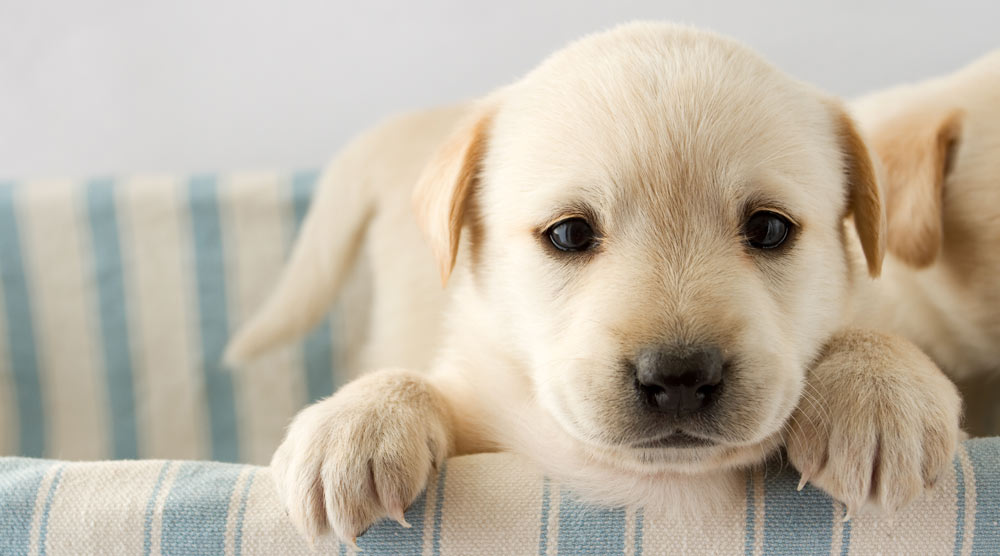New puppies need a surprising amount of gear! From fun puppy toys to a high-quality crate, choosing the right products ensures your dog is comfortable, happy, and safe.
On the other hand, it’s easy to get carried away and purchase items that you don’t really need! Our new puppy checklist (including a printable PDF) will help you stay focused on getting the items that are truly important.
Contents
New Puppy Checklist: 31 Items for Your Puppy
Listed below are 31 items that can be important to buy for a new puppy. We’ve separated the items into categories, with more optional gear at the end.
This sounds like a lot, but not all the items are necessary for every new puppy. Some are also only small purchases, such as poop bags or treats.
Keep in mind that a reputable breeder may provide some items when you pick up your pet. It’s worth checking in advance, so you don’t buy duplicates. For certain items, like harnesses, it’s also better to wait until your pup has arrived so that they can be measured for the correct size.
Tip: Don’t forget to dog-proof your home before your puppy arrives. You want to ensure it’s as safe as possible, and that you minimize the opportunities for them to create mischief!
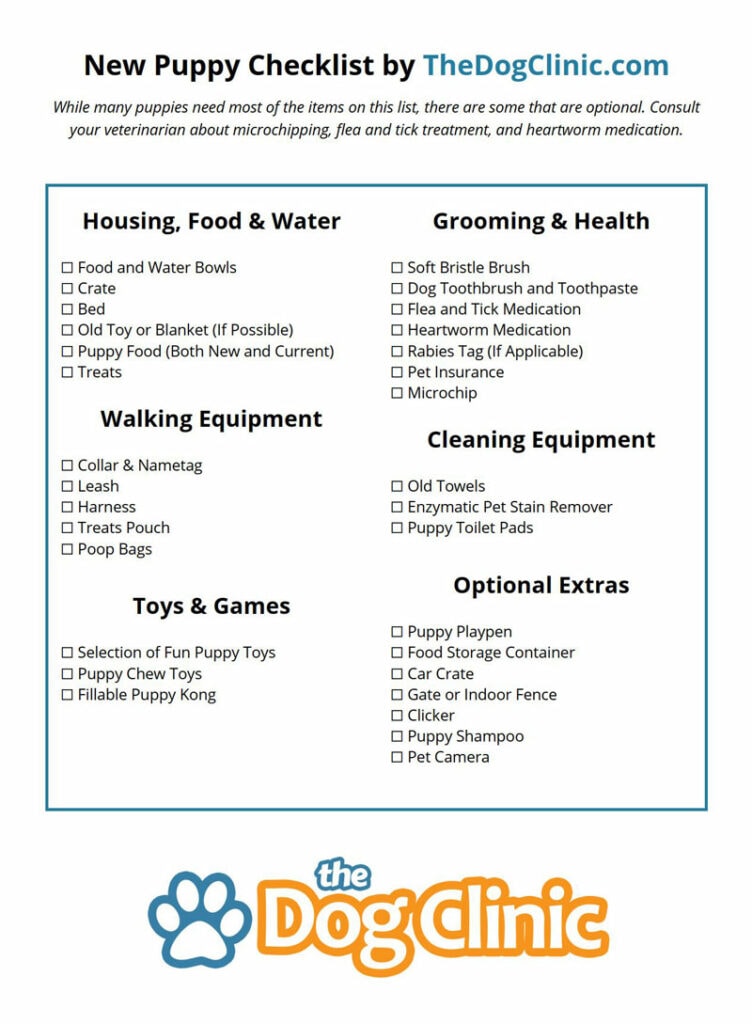
Housing, Food & Water
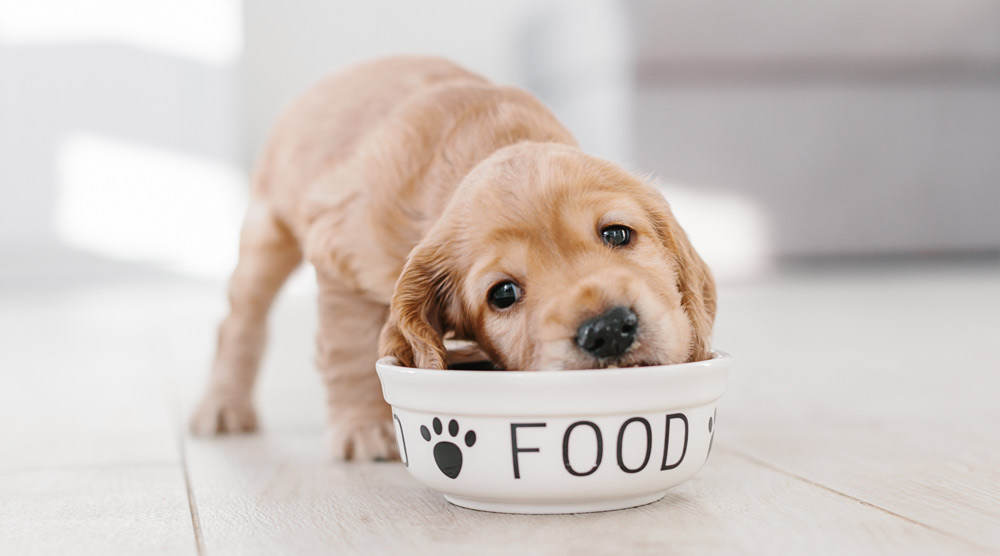
1. Food and Water Bowls
You’ll need at least two bowls for your dog’s food and water.
Simple non-slip stainless steel, plastic, or ceramic dog bowls are all good choices. Make sure you don’t go for something too big, otherwise, it could be tricky for a small puppy to access their food and water.
For water, you might consider a spill-proof option if you’re getting a breed known for being a bit slobbery. Slow-feeder bowls can also be helpful for deep-chested breeds who are prone to the life-threatening stomach condition known as bloat.
Whatever bowls you opt for, make sure that fresh water is supplied every day. All bowls should also be cleaned regularly to prevent a build-up of mold or bacteria.
Tip: Once your puppy is eating confidently from a regular bowl, food toys can provide extra enrichment.
2. Dog Crate
A dog crate provides your puppy with a den-like space they can retreat to when they need quiet time. Crates can also help with toilet training, especially through the night, and can be a safe space to leave your pup unsupervised.
Choose a size that offers your pup enough space to stand up, stretch out fully, and turn around without being constricted. The crate shouldn’t be too big though, otherwise your puppy may decide to use one end for toileting.
If you buy a crate that’s big enough for your puppy to grow into, make sure it comes with a divider so you can create a temporarily smaller space. This helps the puppy to feel cozy and limits the chance of them using the far corner of the crate as a potty space.
How to Introduce a Crate
Crate training should be progressively introduced. Don’t stick your pup inside, close the door and expect them to settle instantly. They also shouldn’t be left in a crate for long periods.
It’s essential that a crate is only associated with positive experiences. Never force your dog into the crate, and make sure you don’t fall into the trap of using it as a punishment space. If your pup only associates it with negative things, they’ll never be able to relax inside.
Instead, start by leaving the crate door open and placing treats and toys inside. You can also give your dog his meals in the crate, so he learns that it’s where positive things happen.
During the first few weeks, it’s a good idea to sleep next to your puppy. This helps them settle into their new environment and reduces the chance of separation anxiety.
You can do this by placing the crate next to your bed, so the puppy can see you, or sleeping on the sofa downstairs. Either way, make sure to take them out regularly to avoid accidents.
When your puppy is settled and sleeping through the night, you can start to move the crate gradually further away from you each night, until your puppy is sleeping in his long-term spot by themselves.
3. Dog Bed
Even if you plan to allow your dog access to the sofa, they still need a bed of their own that can be positioned in a peaceful space in the house.
There are many high-quality dog beds on the market. Bolster beds are great for curling up against, while flat beds allow your pet to stretch out. Memory foam mattresses are probably the most supportive, but they are also pricey and can be difficult to clean
It’s best not to buy anything too expensive to start with. Puppies can be prolific chewers, and the stuffing in beds can be a tempting target. They also grow quickly, so are likely to outgrow their bed at least a couple of times during the first year.
Make sure you choose a bed that’s washable though. A water-resistant exterior liner is sensible too – in case your pup has an accident.
4. Old Toy or Blanket (If Possible)
A reputable breeder or rescue should allow you to drop off a soft toy or blanket when you’re visiting the puppy. This can be put alongside the mother and littermates to absorb their scent.
When you get home, the familiar smells can be comforting for your puppy. Place this toy or blanket in the crate to help them sleep at night.
5. Puppy Food
Ideally, when you bring a new puppy home, you’ll want to give the same food they have been eating with the breeder or rescue shelter. You should ask the breeder which food the puppy has been given, so you can buy some in advance.
A sudden change to a new diet, even if it’s to a better quality food, can cause an upset stomach. It takes time for a dog’s digestive system to adapt to a new diet.
If you have a preferred puppy food or one that is easier for you to get hold of, the puppy should be transitioned onto this over several days.
Always make sure you select a high-quality food formulated for puppies. Young dogs grow rapidly, and they need the right nutritional balance to support their developing bones, muscles, and organs.
“Remember to adjust the amount of food you give your puppy according to the brand guidelines,” adds Rebecca Morello, dog trainer. “This will change as they get older and heavier.”
Tip: Large breed dogs are more prone to musculoskeletal and joint problems as they mature. It may help to choose a food produced for bigger puppies, or a food with lower than average levels of calcium and phosphorus. Studies have shown this can help to control young dog growth rates and reduce the risk of conditions like arthritis as they mature.
6. Treats
Consistency, patience, and rewards are needed when it comes to training your puppy. Making sure you have lots of high-value treats to reinforce desired behavior builds confidence and keeps your pup focused and motivated.
You’ll be rewarding your puppy for lots of different things, including toileting outside, keeping all four paws on the floor, and settling in their bed or crate. It’s important to have a constant supply of treats, as you don’t want to miss a chance to reinforce a behavior.
According to Tufts, treats shouldn’t make up more than 10% of your pup’s daily diet, however, so look for a variety of small, low-calorie, and healthy options. You can also use a portion of your puppy’s regular meal as a treat to avoid overfeeding.
“Using soft treats that can easily be broken into small pieces means even the tiniest breeds can be given the right amount,” says Rebecca Morello, a qualified dog trainer.
Changing up the treats can help to keep your pup engaged. You can save the most high-value options, like plain cooked chicken, for cues you want to master fastest, or when you’re working in a more distracting environment.
Make sure whatever you select is suitable for puppies – it’ll usually tell you on the packaging.
Walking Equipment
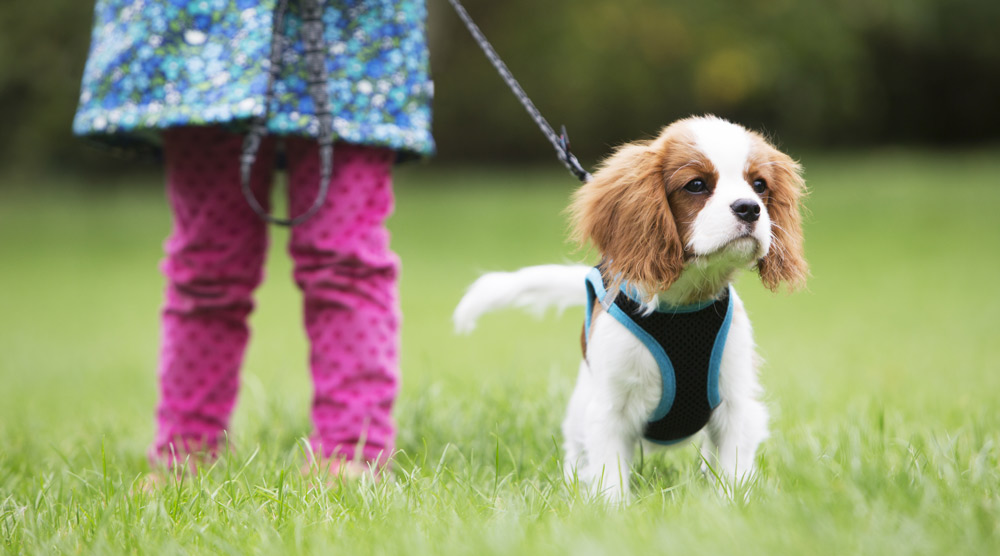
7. Collar & Nametag
As soon as your pup is able to start going out for walks, they should be wearing a collar and ID tag. A lightweight, flat, easy to adjust collar that has a quick-release buckle is often the best choice.
If you’re crate training your dog, it’s a good idea to take the collar off before they go inside to minimize any risk of it getting caught.
In fact, removing the collar whenever your dog is indoors is sensible if you live in a multi-dog household – as long as the house and garden are fully secure. That way there’s no chance of the collars getting caught or twisted during play sessions.
8. Leash
A dog leash is an essential purchase, but there are many options on the market. An adjustable and lightweight training leash is often a great choice for puppies.
These are not the same as retractable leashes. While the length can be adjusted by moving a second clip, the leash doesn’t retract or extend based on your dog’s movement. This allows you to keep close control when near traffic or other dangers, but provide more freedom for your dog to sniff and explore when appropriate.
It can also be useful to buy a long line for practicing recall. Long lines, as the name suggests, are much longer than a regular leash, allowing your puppy freedom without the risk of them running away.
Long lines should only be used in quiet open spaces. These leashes can get easily tangled around trees, other dogs or people’s legs if you aren’t vigilant. You should also only ever attach a long line to a harness, rather than a collar, to protect your dog’s neck.
We don’t recommend retractable leashes for puppies. These can reinforce bad habits and, if the mechanism fails, could be dangerous when near traffic. They can also cause nasty burns and other injuries if they run through hands too quickly or get wrapped around your legs.
9. Harness
A well-fitted harness takes the strain off your dog’s delicate neck area when attached to a leash, especially if he’s pulling or lunging.
In this situation, a collar can cause neck injuries, nerve damage, and pressure on the eyes, making a harness an essential purchase for your new puppy (especially as it’s rare for young dogs to walk calmly!)
The harness shouldn’t sit high up on the neck, and shouldn’t restrict your dog’s gait or leg movement. An adjustable design is also important, otherwise it’s hard to get a snug fit.
“I always recommend walking a dog on a harness rather than a collar to prevent neck injuries,” says dog trainer Rebecca Morello. “In particular, Y-fronted harnesses distribute pressure more evenly and don’t restrict a dog’s movement, unlike ones that sit across the shoulder bone.”
“For puppies with short fur, such as Greyhounds, Great Danes, and Boxers, consider getting a harness with extra padding or fleece coverings for delicate areas such as armpits.” She adds that some deep-chested breeds with narrow necks may need a custom harness to get a safe fit.
While a harness is an essential purchase, it’s best to wait until your dog arrives so you can measure them. Remember to check the fit regularly, as puppies grow fast!
Note: For dogs with respiratory issues, including brachycephalic breeds, it’s even more important to stick with a harness. These puppies already have breathing issues, so pressure on the trachea can make walking very uncomfortable.
10. Treats Pouch
To save your pockets from getting smelly and full of crumbs, investing in a training treat pouch is a good idea. Timing is key when rewarding good behavior, and a treat pouch offers quick and convenient access to yummy dog snacks. Many pouches also have pockets for poop bags, clickers, and other important items.
There’s a wide variety of treat pouches on the market, and they all have their pros and cons. Try a few to decide on the style that’ll work for you.
11. Poop Bags
It goes without saying that poop bags are essential for all dog owners. It’s important to be a responsible owner, and part of that is picking up your dog’s mess (even if it’s not the most pleasant task!)
There is a surprisingly wide range of options. Some have handles, some come on rolls, some are fragranced, and some are compostable. It’s also possible to buy a dispenser that can be attached to bags, treat pouches or leashes.
There’s no reason to overthink this purchase when you get your puppy though. You’ll have plenty of opportunities to experiment to figure out your preferences!
Toys And Games
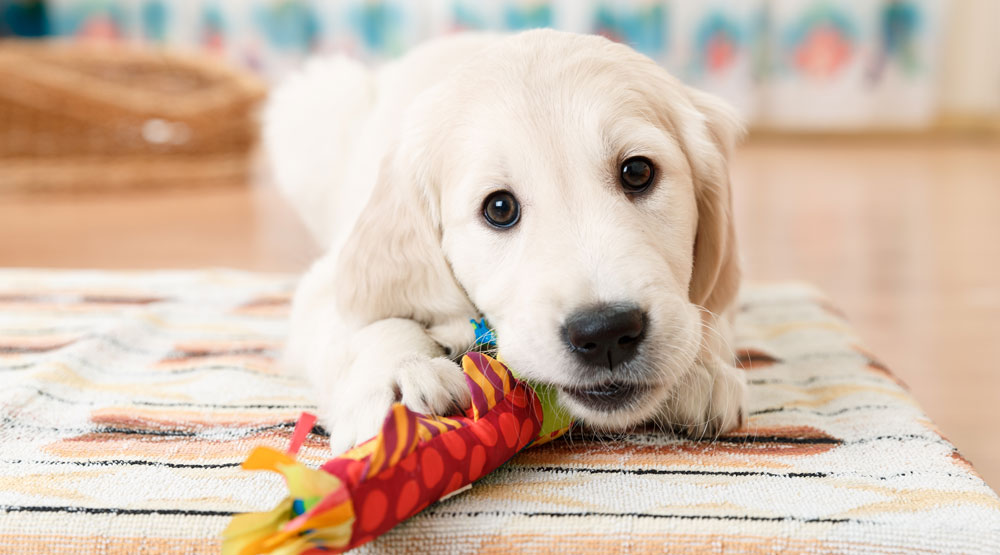
12. Selection of Fun Puppy Toys
Making sure your dog has access to a selection of different toys is essential for providing mental and physical stimulation. Toys encourage confidence and independence, while reinforcing a playful nature that will last a lifetime. Playing with toys with your pup is also a great way to strengthen your growing bond.
Every puppy is different in terms of what motivates them and how hard they are on their toys, so a little experimentation will be needed. Make sure you also rotate their selection to keep the toys fresh and interesting.
Some popular types of toys include rope tug toys, durable non-edible chews, interactive treat toys, soft and squeaky toys, and ones your pup can play fetch with. Be aware that puppies are notorious chewers, so it’s important to supervise your pet to ensure he doesn’t try to eat the stuffing, squeaker, or other potential hazards.
It’s also important to keep your dog safe during play. “It’s really important to remember a puppy is not capable of making good decisions for themselves,” says Rebecca Morello, dog trainer. “For example, I often see new owners throw balls again and again in order to try and tire out their puppy. However, the puppy will keep running to the point of exhaustion and it can be damaging for growing bones.”
13. Puppy Chew Toys
Puppies are natural chewers who explore with their mouths – especially during the teething phase that starts at around four months.
Having a selection of chew toys means you can redirect your pup to a safe target when they inevitably try to chew less appropriate items around the house. Chew toys are often made with strong rubber that can withstand the average puppy’s chewing strength.
It’s not just about saving your slippers though. These types of toys can soothe sore gums and are the best option for dogs that are determined to destroy squeaky toys.
“It’s really important to get the right size chew, which is why I recommend my clients buy them at a pet store initially,” says Rebecca Morello, IMDT dog trainer. “For tiny puppies, make sure your pup can still get their mouth around the chew. And for big breed pups, make sure it’s not a choking hazard.”
For power chewing pups that destroy all but the toughest items, check out our list of seriously strong chew toys. Just be aware that these toys lack the flexibility of typical puppy toys and won’t be as gentle for sore and inflamed gums.
14. Fillable Puppy Kong
Classic Kongs are one of the best-selling dog toys – and for good reason. They’re tough and great for both general play and mental enrichment.
Because they can be stuffed with food or treats, Kongs are ideal for keeping your puppy occupied. They provide a good mental challenge and can encourage your pup to settle in a crate or when you start leaving them for short periods.
The puppy version of the Kong is made of a more flexible rubber than the adult version, so it’s gentler on teething gums. For pups with strong jaws, going for the classic adult version may be a better option though.
Grooming and Health
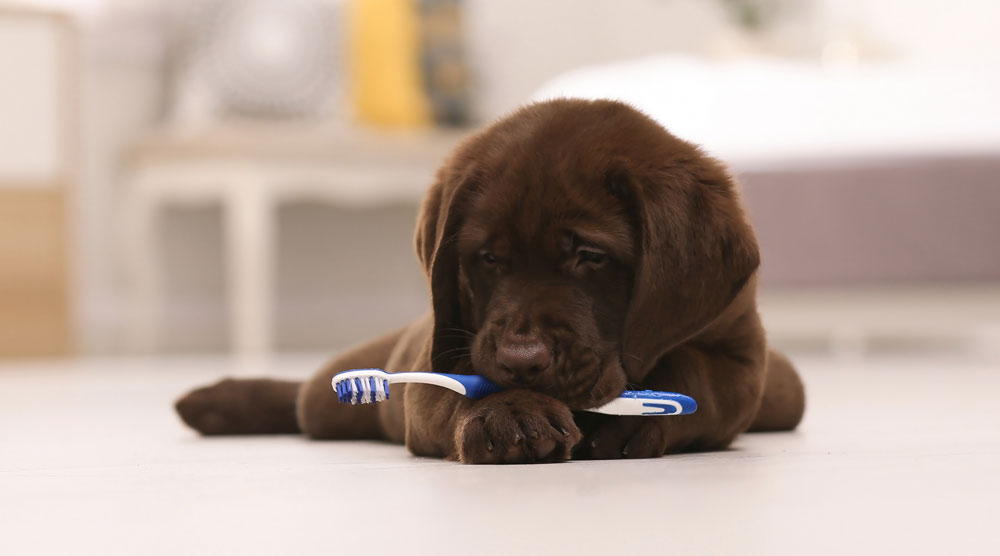
15. The Right Type of Dog Brush
All puppies benefit from positive grooming sessions, regardless of the length of fur. Grooming can promote a healthy skin and coat and, when performed positively, it’s a good way to bond with your dog and get them used to handling.
A puppy’s hair tends to be softer and more delicate than adult dogs. Their skin can also be more sensitive, so it’s usually best to start with a gentle bristle brush.
As your puppy grows, it’ll be important to buy brushes that are effective at grooming their coat type. Yorkies, for example, have a long, continually growing coat that is prone to getting tangled. A pin brush is a great choice for gently teasing out tangles in long hair. Double-coated breeds with short fur, like Labradors, can benefit from a bristle brush.
If you have a long-haired or fluffy dog that will need regular trips to the groomer, consider taking them when they are young. This helps the puppy get used to the sights, sounds, and smells of the salon. A reputable groomer will offer puppy introductory sessions to make their first real groom less scary.
16. Toothbrush and Toothpaste
The importance of dental hygiene can’t be underestimated. Studies have shown that over 80% of dogs suffer some stage of gum disease by the time they’re just three years old, so it’s essential to take care of your puppy’s teeth.
Although there are lots of chews and other products on the market to assist with teeth cleaning, nothing beats brushing. The sooner you get your pup comfortable with tooth brushing, using a gradual desensitization and positive reinforcement program, the easier it’ll be to maintain dental hygiene.
Make sure you pick a doggy-specific toothbrush and never use human toothpaste. The frothing properties can be problematic, as your dog can’t rinse his mouth. More importantly, human toothpaste often contains an artificial sweetener called xylitol, which is toxic to dogs.
17. Flea and Tick Medication
Fleas and ticks can be a huge problem for dogs, and prevention is better than cure. Making sure you administer a safe and puppy-appropriate treatment is recommended.
If your puppy gets a flea infestation, it can cause skin problems and discomfort, and, in severe cases, can lead to anemia and sickness. The fleas can also spread through your home and are tricky to eliminate.
Over-the-counter supermarket treatments aren’t always effective and sometimes cause side effects. It’s best to speak with your vet about the types of treatments available for puppies and their pros and cons.
18. Heartworm Medication
Heartworm is a devastating disease passed from infected mosquitoes. If left untreated, it will ultimately lead to a dog’s death.
Preventing infection is much simpler and more cost-effective than treating a dog already suffering from heartworm. Most vets recommend that treatment be given year-round, as the prevalence of heartworm is on the rise across the United States.
The American Heartworm Society recommends treatment commences in puppies no later than eight weeks of age. You should speak to your vet about annual testing, as this is required even when on a treatment plan.
19. Rabies Tag (If Applicable in Your Area)
Whether you need a rabies tag depends on the rules in your country, so it’s important to check this before you get a puppy.
Most states in the USA require that dogs are vaccinated against rabies. However, the laws and regulations aren’t consistent, and what is required across each state can be confusing and convoluted.
Annual vaccination is widely required, and your dog should also wear a specific rabies tag. This is changed annually to show the year and an identifiable number. Your vet will be able to advise on the requirements in your region.
20. Pet Insurance
Many people resent paying for pet insurance. It’s true that your pup could go through their entire life without needing to make a claim, which would make monthly insurance costs seem like an unnecessary expense.
However, if your dog develops a chronic condition or has a debilitating accident, vet bills can rack up. Pet insurance gives you peace of mind that, should the worst happen, you won’t have to worry about the financial implications.
Policies vary greatly in terms of their coverage and pricing. Make sure that you study the policy documents before making a decision on which insurance you feel is right for you and your pup.
Be aware that most policies won’t cover pre-existing conditions. So, getting insurance as quickly as possible is recommended.
21. Microchip
Unless you have a dog that falls under state-mandated breed specific legislation, microchipping is voluntary in America. Any responsible dog owner, however, will make sure their puppy is microchipped. In other countries, such as the UK, microchipping is mandatory, so check the rules in your area.
Even if you have an ID tag, this can come off if your dog is lost. It also won’t help if your dog is stolen. AKC Reunite has reported that dogs with a microchip are 20 times more likely to be successfully reunited with their owners.
Cleaning Equipment
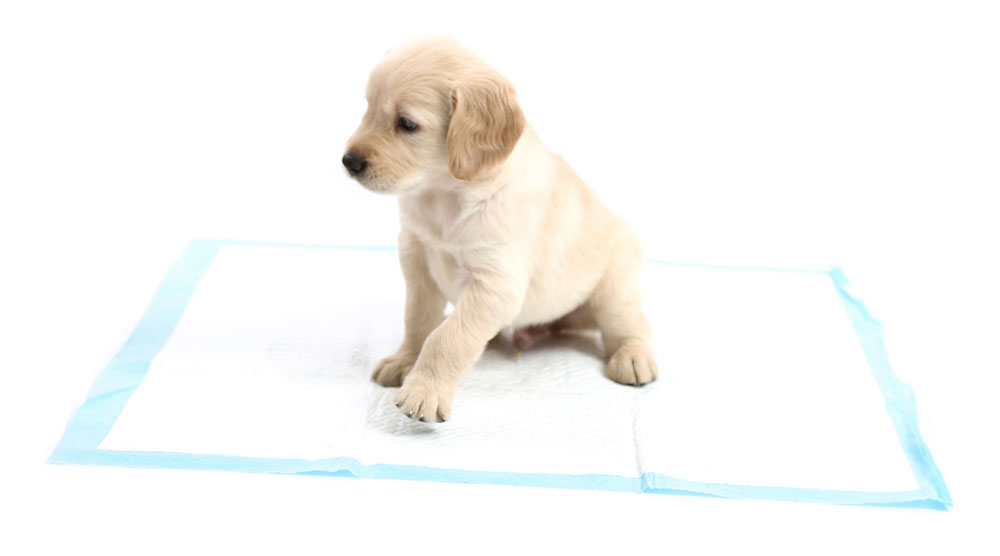
22. Old Towels
The journey home for your new puppy can be overwhelming for them. If it’s long, there’s a good chance they’ll have an accident, even if you’re stopping for potty breaks along the way.
Old towels are easy to remove and wash if that happens. They’re also handy at home for drying wet paws or if a bath is needed.
23. Enzymatic Pet Stain Remover
It’s unrealistic to expect there to be no potty accidents in the house – no matter how diligent you are about taking your puppy outside. And, when your dog urinates in a particular spot, the scent means they’re more likely to go there again.
To solve this problem, it’s best to use a specially formulated pet stain and odor remover, rather than traditional floor or carpet cleaners.
The ones that contain enzymes will more effectively break down the uric acid responsible for stains and the strong smells. This makes it less likely that the dog will have accidents in the same spot.
24. Puppy Toilet Pads
The best way to potty train a puppy is to take them outside as often as possible and reward them for going to the toilet in the right place. This makes accidents less likely and consistently reinforces the “right” place to go.
However, if you live in an apartment, have a small dog with a little bladder, or your schedule makes it difficult to go out so often, you may want to consider using puppy toilet pads as an interim solution.
These are more absorbent than newspapers and can be used to teach your dog to potty in a designated spot.
Just be aware that puppy pee pads will significantly slow down the toilet training process. Pads encourage your dog to pee indoors, which makes it less likely to go in the garden. However, in some situations, toilet pads are the only option, such as if you live in a high-rise apartment.
Optional Extras That You May Find Useful
25. Puppy Playpen
Puppy playpens might not seem essential, but they can make life a lot easier during the first few weeks and months.
You can’t watch your dog all the time, but it’s amazing how quickly a puppy can get into potentially dangerous situations. Playpens provide your pet with a safe space to play or relax, which can be convenient when you’re cooking, showering, or any other time when you can’t supervise. They can also be useful if you’re taking them to an outdoor space that isn’t secure.
Introducing your pup to a playpen is similar to crate training. It should always be done gradually and positively. Don’t use a pen as a punishment area and avoid leaving your pup in it for long periods.
Instead, fill the pen with fun toys, a comfortable bed, and a water bowl. Giving your puppy a stuffed Kong or chew can also be a great way to teach them to relax when in the pen.
Large breed dogs aren’t generally suited to playpens, as they don’t offer enough space and the fence can sometimes be scaled or jumped.
26. Food Storage Container
Buying your puppy’s food in bulk can save a lot of money. However, once opened, these big bags often go stale. Humid environments can also lead to the food going soft, or developing mold and bacteria. Open bags of food can even attract vermin in your house.
Keeping food in an airtight food storage container can help to prevent these issues. A storage container also ensures your puppy can’t access the food when it’s not mealtime.
27. Car Crate
Dogs should never be loose in a car. Allowing your dog to travel without a safe crate or car harness puts them at much greater risk of getting injured if you have an accident. They can also be distracting, especially if they climb over you when driving.
We recommended buying a crash-tested car harness or crate to keep your pet secure. Most harnesses are not crash-tested, even if they have a seat belt loop, so don’t rely on a regular harness to keep your puppy safe. The same is true for most crates, which will crumple in an accident.
For some dogs, traveling in a secure crate can also lessen anxiety and reduce the chances of car sickness.
28. Gate or Indoor Fence
If your dog is too big for a puppy pen, or you want to block access to certain areas in the house or garden, then a portable fence or baby gate can be beneficial.
These can be especially useful if you want to manage initial interactions between an excitable new puppy and a resident dog or young kids. Baby gates can also be a good way to teach your dog to feel comfortable being in a different room, while still being able to see you.
Make sure the height and size are appropriate for your dog before buying. Your puppy may be wary of the gate to begin with, so introduce it slowly and with plenty of treats.
29. Clicker
Timing and consistency are essential when training using reward-based methods. Even a short delay in giving a reward can reduce the effectiveness of training, or even reinforce the wrong behaviors.
A clicker is a gentle and effective tool to help your dog understand exactly which behavior is being rewarded. The idea is to press it the moment your dog offers a desired behavior and then immediately offer a tasty food reward. Before long, the dog associates the click with a reward, so you can precisely mark the right behaviors.
This is a basic explanation, but the video below provides more detailed instructions on how to use a clicker:
30. Puppy Shampoo
Puppies have more sensitive skin than adult dogs, and their coat tends to be softer too. Opting for a specially formulated puppy shampoo is a good idea for bath time. These shampoos are mild and less likely to irritate the skin.
Don’t be tempted to use your own shampoo on your pup (including baby shampoos.) Human shampoos contain ingredients that can be harmful to dogs, and are designed for our more acidic skin. Using them frequently can disrupt your dog’s natural skin barrier, leading to irritation, dryness, and even increase the risk of bacterial infection.
31. Pet Camera
Pet cameras are a relatively new addition to this list, but they can make those first few months with your puppy a lot easier.
“I always recommend that new puppy owners purchase a pet camera that links to their phone,” says dog trainer Rebecca Morello. “This gives peace of mind when you aren’t in the same room as your puppy, particularly if you have recently transitioned from sleeping next to them.”
She adds that a pet camera can be particularly useful when you start to leave your puppy alone. “Being able to see their reaction and know their limits when alone makes it easier to build up alone time at the right pace.”
Bonus Items: Hidden Gems From a Dog Trainer
We asked Rebecca Morello, IMDT dog trainer, whether she had found any hidden gems that help with raising a young puppy. Here are a few of her top recommendations, along with why she uses them:
- Wooden spoon. “These are great for teaching loose-lead walking, especially with small dogs. You can pop some peanut butter on it and hold the spoon where you want them to walk.”
- Horse line. “This works the same as a training long line and is often cheaper.”
- White noise machine or mobile phone app. “White noise is great for helping puppies sleep through household noise and get those much-needed daytime naps.”
- Cardboard boxes. “Pop some treats and puppy-safe materials inside a box to provide both physical and mental stimulation.”
Which Items Do You Need for a Puppy’s First Day And Night?
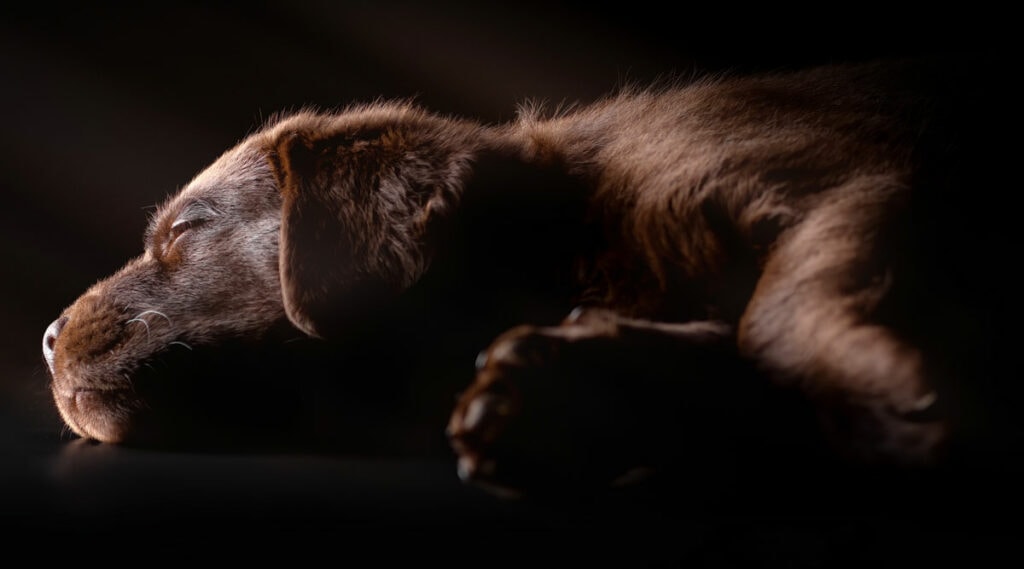
You’ll need most of the items mentioned in our puppy gear checklist before long (although there are some exceptions), so it’s best to get as many as possible before you pick your puppy up.
However, if you don’t have time to gather every item, here’s a list of must-have supplies to get you through the first night and day.
- Food and water bowls
- Crate
- Dog bed and blanket
- Puppy food that matches what the puppy is currently eating
- Collar and nametag with contact information
- Poop bags
- Puppy chew toys
- Old towels
- Puppy playpen
Quality Vs. Price: A Dog Trainer’s Perspective
Getting a new puppy is expensive! We asked dog trainer Rebecca Morello how new puppy parents can make savings without compromising their dog’s wellbeing. Here’s what she had to say:
“Firstly, I always recommend checking both online and in local pet stores. It is amazing how the same gear in one place can be much more costly in another. It’s also worth monitoring Facebook Marketplace and asking friends and family for second-hand items.”
“Puppy parents with large breed pups will likely end up spending more in terms of gear because everything needs to be more durable and stronger. For example, a puppy parent with a Maltese can probably get away with using a cheap, lightweight dog pen, whereas a Labrador puppy will easily knock this over.”
“Bedding can be put together cheaply when you have a young puppy. Generally, it is not worth spending lots of money on pricey beds that will likely get peed on, ripped up, and quickly outgrown! Just make sure your pup has somewhere soft and warm to lay – even if this is just a few old blankets and towels rolled up.”
“The most important area to invest in is walking gear, because this is a huge part of your puppy’s safety. Flimsy leads can be chewed through very quickly, badly fitting harnesses can be slipped out of, and poorly made collars can cause chafing. These are all items that I recommend spending a bit more on.”
The Most Important Things (Preparation, Research, and Love)…
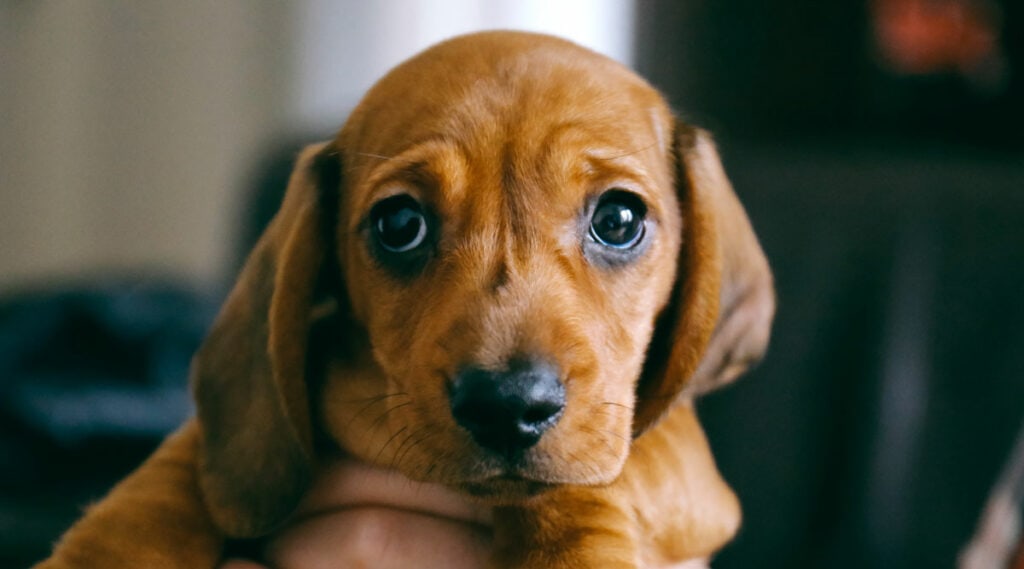
Making sure your puppy has all the right gear is important. But love, patience, and realistic expectations are key to helping your dog feel at home.
Puppies aren’t born knowing what humans expect from them. Accidents in the house, chewed items, and whining at night should all be anticipated. Be mentally prepared for these issues, so that you can respond to them in a kind and calm way.
If you share your home with other family members, make sure everyone is aware of the responsibilities and time commitment associated with getting a new puppy.
You can have a house full of accessories, but the priority is to make sure your pup gets the love and respect they deserve. It’s also important to remember that building a bond and developing a trusting relationship takes commitment, patience, and positive training.
Tip: To learn more about how to prepare for the first week with your puppy, read our new puppy guide.

The Importance of Positive Puppy Training Classes
Every dog can benefit from puppy classes. They are a brilliant opportunity for controlled and appropriate socialization and learning. Novice dog owners can also learn a lot about the basics of dog training and behavior.
It’s important to ensure that the class is being run by a qualified dog trainer who uses positive, reward-based training techniques.
Classes that promote the use of punishment, force, or aversive tools (like slip leashes and choke chains) should be avoided. Training your dog using these methods can be detrimental to the bond you’re forming with your pup. It is also more likely to lead to fearful behavior or aggression.
Studies have shown that training using positive techniques is more effective in the long-term, and you’ll have a much happier dog too.
Summary
The weeks leading up to the arrival of your new puppy are often a mixture of excitement and anxiety. It’s easy to forget about a vital piece of equipment, which can make the first day more stressful than it should be.
We hope this new puppy checklist makes it easier to gather all the gear, food, and other items that your dog needs. If you have any questions, please let us know in the comments section below. You may also want to read our guide to how to bond with a new puppy.
